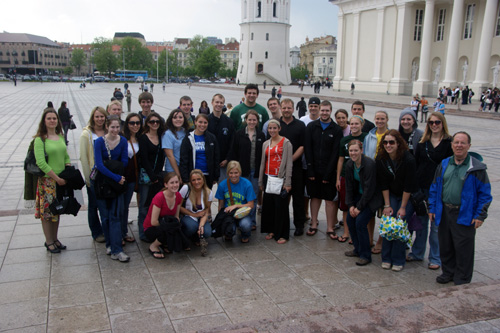
If it’s Thursday, we must be in Vilnius. We spent most of the day getting here, transiting through Latvia to Lithuania. As we got farther south, the agriculture seemed more “regular”–which is to say, more like back home, with some cows, and a lot less forest. The northern areas looked more like the Northwoods of Wisconsin, with miles and miles of tall pines.
Again, we’ve changed languages (Lithuanian, we were told, is as close as any language today to Sanskrit), currency (I think travelers are going to welcome the eurozone all being on the euro; right now, many are using their own currencies. Our guide says the Baltic citizens love to travel and use the euro, then love to use their own currencies when they get home), and their own histories. I suspect personal views of the three are rather like those Wisconsin and Illinois share–except the Baltic peoples do speak different languages.
Lithuania is the largest of the Baltic countries, at around 3.5 million, with a large diaspora in the United States and elsewhere, including Jim Meizelis’ family (Jim was a long-time friend of my Scout troop, who has asked me to find the real meaning of his name). Our guide told us Lithuania was the only Kingdom in the Baltic, a short-lived state that “married” to Poland, and wound up with an area from the Baltic almost to the Black Sea at one time. It then “enjoyed” the fate of its northern brothers, enduring war and revolution, including a threatened attack from the Turks. Vilnius is the largest city in the country, with about 600,000 population. Though it was the capital of historical Lithuania (the kingdom apparently lasted for only one king), Vilnius, I just learned, was part of Poland in the interwar period, when Lithuania (like Latvia and Estonia) gained their independence. Even today, Lithuania has a large Polish minority, and a small enough Russian minority to have given the Russians citizenship after 1991, which was unusual in the Baltics.
We had about a three-hour tour of the old town, which has some very 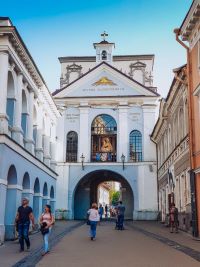 distinctive churches. Lithuania was a bastion of Catholicism (I think I heard 95% Catholic), bolstered by the Pope’s sending of the Jesuits here to spearhead the counter reformation (we’re learning a lot of European history; as one of the students marveled, “They’ve got a lot more of it than we do”). The result was the founding of a university that is the second oldest in Europe–it still exists today, hampered by Lithuania’s joining the European Union (along with NATO; someone needs a
distinctive churches. Lithuania was a bastion of Catholicism (I think I heard 95% Catholic), bolstered by the Pope’s sending of the Jesuits here to spearhead the counter reformation (we’re learning a lot of European history; as one of the students marveled, “They’ve got a lot more of it than we do”). The result was the founding of a university that is the second oldest in Europe–it still exists today, hampered by Lithuania’s joining the European Union (along with NATO; someone needs a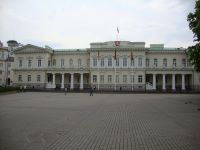 geography lesson!); we passed it today. It’s near the Presidential Palace, which was the governor’s house under Russian rule, the Nazi HQ etc., etc.
geography lesson!); we passed it today. It’s near the Presidential Palace, which was the governor’s house under Russian rule, the Nazi HQ etc., etc.
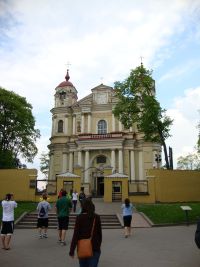 The main features we saw were the baroque churches (which is why I mentioned we went for baroque), not quite as over the top as some I saw
The main features we saw were the baroque churches (which is why I mentioned we went for baroque), not quite as over the top as some I saw 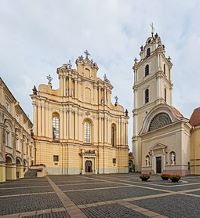 last summer in Germany; a late Gothic church that Napoleon is reputed to have said he wanted to put in his hand and take back to Paris; his soldiers used it to stable their horses in winter and burned the wooden fixtures to stay warm; a “black Madonna”–the oak wood aged; parts of a city wall; and the former Jewish ghetto. At one time, Vilnius had a large Jewish population, almost 40 percent of the city’s population. It was known as the Jerusalem of the North, and I want to say that Jascha Heifetz, THE violinist of my youth, was born here. The Nazis wiped out over 300,000 Jews during the Holocaust, and a lot of Lithuanians as well. It’s a similar story elsewhere in Europe, and I’m sure we’ll have more to report after our next stop, which is Warsaw.
last summer in Germany; a late Gothic church that Napoleon is reputed to have said he wanted to put in his hand and take back to Paris; his soldiers used it to stable their horses in winter and burned the wooden fixtures to stay warm; a “black Madonna”–the oak wood aged; parts of a city wall; and the former Jewish ghetto. At one time, Vilnius had a large Jewish population, almost 40 percent of the city’s population. It was known as the Jerusalem of the North, and I want to say that Jascha Heifetz, THE violinist of my youth, was born here. The Nazis wiped out over 300,000 Jews during the Holocaust, and a lot of Lithuanians as well. It’s a similar story elsewhere in Europe, and I’m sure we’ll have more to report after our next stop, which is Warsaw.
The Baltics have been a real treat, and I think our students have enjoyed them. A little rigor-mortis (in Riga!) set in this morning from last night’s two birthday celebrations, so everyone is enjoying a quiet evening tonight. At least Sascha and I are.